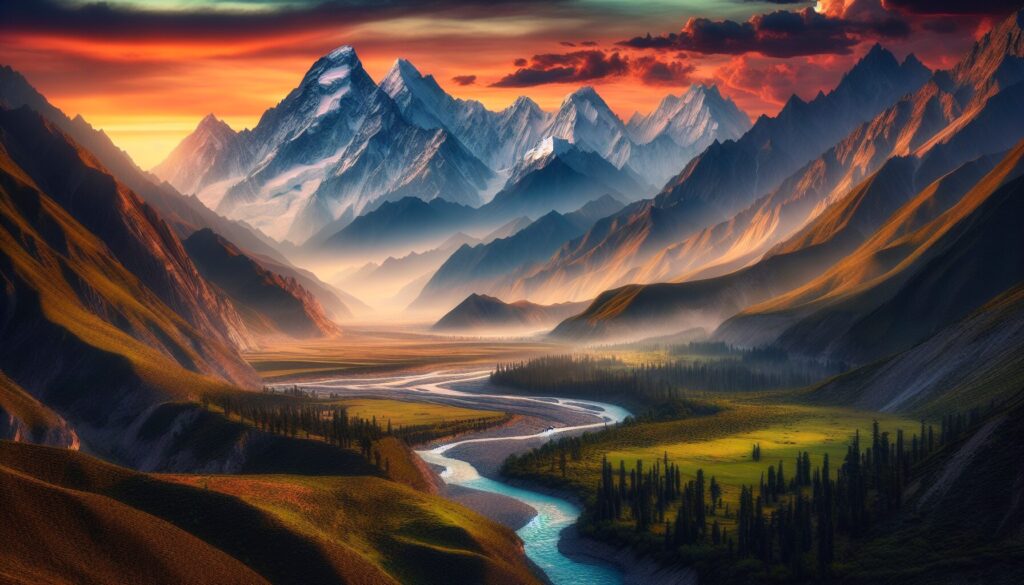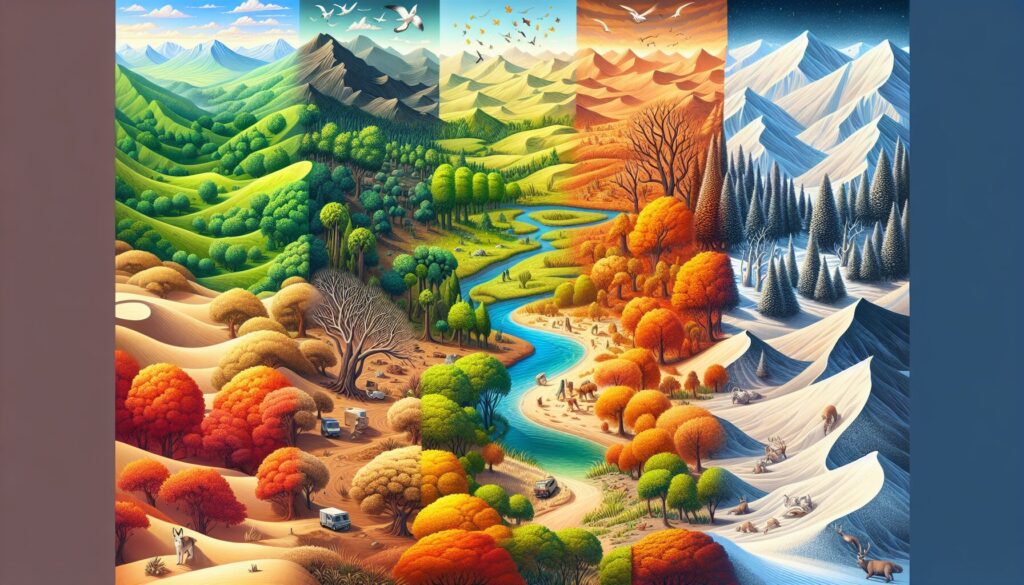The Ultimate Guide to Landscape Photography in Pakistan: Explore Majestic Vistas & Hidden Gems starts with the magic of capturing the vibrant beauty of places like Fairy Meadows. I remember using a slow shutter speed of 1/15s to capture the ethereal mist over Lake Saif-ul-Malook at dawn. A camera with a full-frame sensor is ideal for these low-light conditions. Whether you’re in the rugged terrains of Hunza Valley or the serene landscapes of Skardu, every click unveils a new wonder. It’s a wonderful journey, filled with breathtaking scenes and hidden treasures. Let’s explore together!
Essential Gear for Capturing Pakistan's Landscapes
When you’re setting out to capture the breathtaking landscapes of Pakistan, having the right gear makes all the difference. Trust me, I’ve been there, snapping away at the majestic peaks of the Karakoram Range. Here’s what you need in your bag:
Key Camera Features
- Full-frame sensor: Essential for those stunning low-light shots. When I was camped under the clear skies of Deosai, it was my full-frame camera that let me capture the stars in all their glory.
- Weather-sealed body: The unpredictable weather in places like Fairy Meadows can be challenging. A weather-sealed camera ensures you’re prepared for sudden rain or dust storms.
Lens Choices
- Wide-angle lens: Perfect for capturing expansive views like the lush valleys of Swat. A 16-35mm lens can really bring out the vastness of the terrain.
- Telephoto lens: Don’t forget this for distant peaks. A 70-200mm lens helped me photograph the snow-capped peaks of Nanga Parbat from afar.
Tripod & Filters
- Sturdy tripod: Crucial for long exposures. I used a lightweight carbon fiber tripod when shooting the flowing waters of Hunza River with a shutter speed of 1/15s.
- Polarizing filter: Cuts glare and enhances colors. It’s a game-changer for noon shoots in Skardu, making those blues and greens pop.
With this gear, you’re all set to explore majestic vistas and uncover hidden gems across Pakistan’s diverse landscapes.
Top Majestic Vistas to Photograph in Pakistan

Pakistan boasts some of the most breathtaking landscapes, perfect for capturing with your camera. Let’s explore a few of these awe-inspiring spots. One of my personal favorites is the mesmerizing Hunza Valley. Nestled amidst the towering mountains, it’s a haven for photographers. I once captured the sunrise here using a wide-angle lens to emphasize the vastness of the valley. The play of early morning light on the peaks is pure magic.
Must-Visit Locations
- Fairy Meadows: A trekker’s dream, this spot offers a stunning view of Nanga Parbat. When I visited, I used an ND filter to capture the flowing streams with a long exposure, creating a serene, dreamy effect.
- Skardu: Known for its surreal beauty, Skardu’s landscapes are a must-see. The Deosai Plains, often referred to as the ‘Land of Giants’, offer endless photography opportunities. I recommend visiting in late spring when wildflowers blanket the plains.
In addition to these, don’t miss the enchanted Swat Valley, often called the ‘Switzerland of the East’. Its lush greenery and crystal-clear rivers are perfect for experimenting with high dynamic range (HDR) photography. According to a report by Adobe, using HDR can help capture the full range of light and shadow, making your images truly stand out.
For more off-the-beaten-path adventures, consider exploring the mystical Hingol National Park. This hidden gem is home to unique rock formations and coastal beauty that will leave you in awe. Remember, sometimes the best spots are those less traveled!
Discovering Hidden Gems: Off-the-Beaten-Path Locations
There’s something magical about discovering a hidden spot that few have ventured to. One of my favorite experiences was trekking to the enchanting Fairy Meadows. This place is not just a photographer’s dream; it’s a haven for those seeking solitude. To capture the serene beauty of Nanga Parbat, I used a tripod with a long exposure of 30 seconds during the golden hour. The camera’s full-frame sensor helped immensely in those low-light conditions. For anyone heading there, I’d recommend checking with local guides or the Pakistan Tourism Development Corporation for updates on the trail conditions.
Must-Visit Hidden Spots
- Rakaposhi Base Camp: While Hunza is famous, this base camp is often overlooked. The trek is challenging but rewarding. I used a wide-angle lens to capture the vastness of the landscape.
- Deosai National Park: Known as the “Land of Giants,” it’s more than just a park. It’s a sanctuary for wildlife and offers endless landscape photography opportunities. I found that a polarizing filter helped reduce glare from the pristine lakes.
These off-the-beaten-path gems in Pakistan offer photographers a chance to explore majestic vistas and capture nature’s wonders. Next time you plan an adventure, consider these hidden spots. You might just find your next favorite shot!
Best Practices for Ethical and Respectful Photography
When you’re out exploring the breathtaking landscapes of Pakistan, it’s crucial to keep ethical photography at the forefront. Respect for local communities and natural settings is essential. Once, while photographing the serene lakes in Skardu, I used a camera with a full-frame sensor to handle low-light conditions. This allowed me to capture the tranquil beauty without disturbing the peace with artificial lighting.
Respect the Environment
- Stick to marked trails to protect fragile ecosystems.
- Carry out all waste, leaving no trace of your visit.
- Avoid disturbing wildlife; use a telephoto lens to maintain a respectful distance.
Engage with Local Communities
- Always ask for permission before photographing people. A simple gesture can go a long way.
- Understand and respect cultural norms. For instance, in Hunza, a nod from elders often signifies consent.
While capturing the lush valleys of Swat, I found that using a slow shutter speed of 1/15s helped me capture the motion of waterfalls, showcasing their natural beauty without altering the scene. Engaging with locals at places like `Baltit Fort` can offer unique insights into the area’s heritage, adding depth to your photographs. Always prioritize ethical and respectful photography techniques to ensure that these majestic vistas remain untouched for future generations.
Seasonal Tips for Capturing Pakistan's Diverse Landscapes

When you’re out exploring Pakistan’s breathtaking landscapes, timing is everything. Here’s how to make the most of each season with your camera in hand.
Spring and Its Blossoms
Spring transforms the north with vibrant colors. In places like Hunza Valley, cherry blossoms are a photographer’s dream. I once set my aperture to f/8 to get the perfect depth-of-field, focusing on the blossoms while capturing the distant snow-capped peaks.
Summer’s Golden Light
Summer is all about dramatic contrasts and golden light. In the Thar Desert, the sunsets are truly magical. I used a polarizer to enhance the deep blue sky and a wide-angle lens to capture the vastness. Visit Skardu for serene lakes reflecting majestic mountains.
Autumn’s Rich Hues
Autumn in Pakistan is like painting with nature’s palette. The Kaghan Valley’s landscapes are dotted with fiery reds and oranges. A tripod and a slow shutter speed of 1/15s help capture the gentle sway of leaves in the breeze. It’s a must-see for any landscape enthusiast.
Winter’s White Blanket
Winter offers a chance to capture snow-draped vistas. In places like Murree, early morning fog adds a mystical touch. I recommend using a camera with a full-frame sensor for better low-light performance. Adjust your ISO to 400 or higher to handle the dim winter light.
- Use the season’s unique features to your advantage.
- Experiment with settings to capture the beauty you see.
Conclusion
Embarking on a journey to capture the breathtaking landscapes of Pakistan is nothing short of magical. From the towering peaks of the Karakoram to the serene beauty of Lake Saif-ul-Malook, this country offers a canvas like no other. As you delve into the art of landscape photography, remember that the right gear can make all the difference. A camera with a full-frame sensor can be invaluable in capturing the intricate details of a scene, especially in low-light conditions. During my last trip to the Hunza Valley, I experimented with a slow shutter speed of 1/15s to capture the flowing water of a mountain stream, creating a dreamy effect that brought the image to life. It’s these technical touches that elevate your photography from ordinary to extraordinary.
Pakistan’s landscapes are as diverse as its cultures. If you’re seeking untouched beauty, places like Fairy Meadows and Passu Cones should be on your list. Each location offers unique perspectives and challenges, contributing to an ever-growing portfolio. Remember to respect the local culture and environment while exploring these hidden gems. Your camera can capture the heart and soul of these places, but it’s your respect and understanding that will leave a lasting impact. Whether you’re a seasoned photographer or a curious beginner, the wonders of Pakistan await, ready to be unveiled through your lens.
Continue Exploring
Ready to elevate your night photography skills? Dive into our expert guide on capturing stunning star trails with the right techniques, gear, and locations. Unveil the secrets to mesmerizing celestial images today!
Frequently Asked Questions
What are the best locations for landscape photography in Pakistan to capture stunning natural vistas?
Pakistan offers a plethora of breathtaking locations for landscape photography. The northern areas, particularly Hunza Valley, Skardu, and Fairy Meadows, are renowned for their majestic mountains and serene landscapes. Additionally, the Deosai Plains, also known as the Land of Giants, provide a unique backdrop with their vast open spaces and diverse wildlife.
How can I find hidden photography spots in Pakistan that are less explored but offer incredible views?
To discover hidden gems in Pakistan, it’s best to connect with local photographers and guides who have in-depth knowledge of the area. Social media platforms and photography forums can also provide valuable insights into lesser-known spots. Additionally, exploring beyond popular tourist trails and being open to adventure can lead you to uncover stunning, less frequented locations.
What tips can help capture the perfect landscape photos while traveling through Pakistan's diverse terrains?
To capture the perfect landscape photo in Pakistan, plan your shoots around the golden hours of sunrise and sunset for optimal lighting. Use a tripod for stability, and experiment with different angles and perspectives to highlight the unique features of the landscape. It’s also essential to be patient and respect the natural environment to truly capture the essence of Pakistan’s diverse terrains.


Leave a Reply